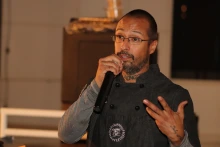Second Annual Agrivoltaics Dinner at Biosphere 2 Brings Problem Solvers Together for a More Resilient Tomorrow
The event brought together researchers, farmers and industry professionals to celebrate the successes of current agrivoltaic research and discuss the future of this emerging field.

On November 8, 2024, Biosphere 2 (B2) hosted the second annual Agrivoltaics Dinner, bringing together professionals and students of various disciplines to celebrate this year’s agrivoltaic crop yield and cross-pollinate experiences and ideas for those researching this emerging technology.
The event, led by former Udall Center Fellow and Professor in the School of Geography, Development and Environment Greg Barron-Gafford, featured a gourmet meal prepared by renowned Tucson chefs Janos Wilder and Pablo Valencia. The produce for the meal was primarily grown under solar panels – the defining characteristic of this novel agricultural method – at three agrivoltaic farms across the southwestern U.S.
Expanding to maximize impact

Coinciding with the Agrivoltaics Dinner, Postdoctoral Researcher Carrie Seay-Fleming hosted an Agrivoltaics Community Workshop before the evening event. The workshop fostered dialogue between rightsholders, farmers, county representatives, elected officials, extension agents and researchers about solar development on farmland and agrivoltaics.
"The workshop was really about understanding community preferences around how agrivoltaics develops in Arizona because we are increasingly sure that it’s technically possible,” Seay-Fleming said. “We tried to center dialogue around structuring agrivoltaics for the benefit of farmers and rural community members.”
"Last time, it was strictly a celebration of the food that can be produced (this way),” Barron-Gafford said about adding a workshop component to the annual event. “This time, we brought together about 70 people from different walks of life; farmers, solar developers, county commissioners, and state representatives to just hash it out,” Barron-Gafford explained.
Agrivoltaics research has been on the radar for a few decades as a way to maximize land use. Findings suggest that integrating solar panels with farmland increases crop yields, particularly in dry climates, and improves solar panel performance as moisture released by plants and soil cools the panels.
Barron-Gafford says that opening the conversation about agrivoltaics research to enable greater community engagement allows people of different disciplines the opportunity to express concerns, facilitate discussions across a broader audience, improve networks, and gain exposure to different perspectives.
“I think being able to talk to people in a way where they feel comfortable asking their what-ifs is always going to be a good thing,” said Barron-Gafford. “But, beyond that, we've been able to utilize some of these conversations to drive some of our own research on the physical science side of things.”
Integrating past knowledge with current technologies for a sustainable future

Not only have agrivoltaics proven effective at reducing water needed for irrigation and improving crop yields, but proponents suggest that this method of farming could also contribute to long-term food security in a changing climate.

Janos Wilder
Chef Janos Wilder joined this year's agrivoltaics dinner at B2 with enthusiasm for the second year running. He suggests that pairing this emerging agricultural method with ancient Indigenous knowledge and locally adapted seeds could prove a crucial solution to preserving our food systems in the face of a warming world. “(These crops have) been growing here for 5000 years,” Says Wilder. “They're not only the foods of the past, not only the foods of the present, but they're the foods of the future.”
When Wilder and Valencia were curating the menu, Valencia explained that the chefs wanted to emphasize the significance of foods produced as sustainably and as locally as possible.
“There's a lot more into it than just meeting people,” Valencia explained, ”because we're all sharing really great ideas about how to expand our food culture, water preservation, [and] about getting food with the lowest travel miles.”

Pablo Valencia
Beyond the sustainability benefits offered by agrivoltaic farming, Valencia also noted the harvests' enhanced quality. “The beets alone, the beets were gargantuan actually! Like huge beets, man… You can't really find those anywhere,” he said.
According to the data, Valencia might be onto something with this observation. Preliminary studies have shown that certain plant varieties growing in a shaded environment can see greater yields.
Introducing the future to agrivoltaics

A recurring theme among those involved in the project was the emphasis placed on community engagement, which is crucial for widespread adoption of novel technology.
One way to advance public exposure to agrivoltaics research is by promoting citizen science projects. The University of Arizona’s School Garden Workshop, where Barron-Gafford is Associate Director, invites students and faculty from local public schools to play an active role in his team’s cutting-edge research.
In these cases, agrivoltaic infrastructure is built on a small scale at a participating school to demonstrate how the system functions and get students involved by creating an active learning environment promoting math and science literacy and integration, art-science fusion, and place-based environmental science.

As the nation continues its march toward more renewable forms of energy, Barron-Gafford suggests that agrivoltaic farming methods could offer a solution to land use strategies that might otherwise seem mutually exclusive.
“We're seeing a transition around the state and around the southwest from areas that used to be farmlands to now being strictly solar… when they used to be breadbaskets,” he says.
“Can you really grow food in and around solar 100 percent? Yeah. And guess what? We're doing it all over the state. And if you put it in the right hands, man, it's delicious.”
Learn more about the agrivoltaic research happening at B2 here.
Learn more about the School Garden Workshop here.

